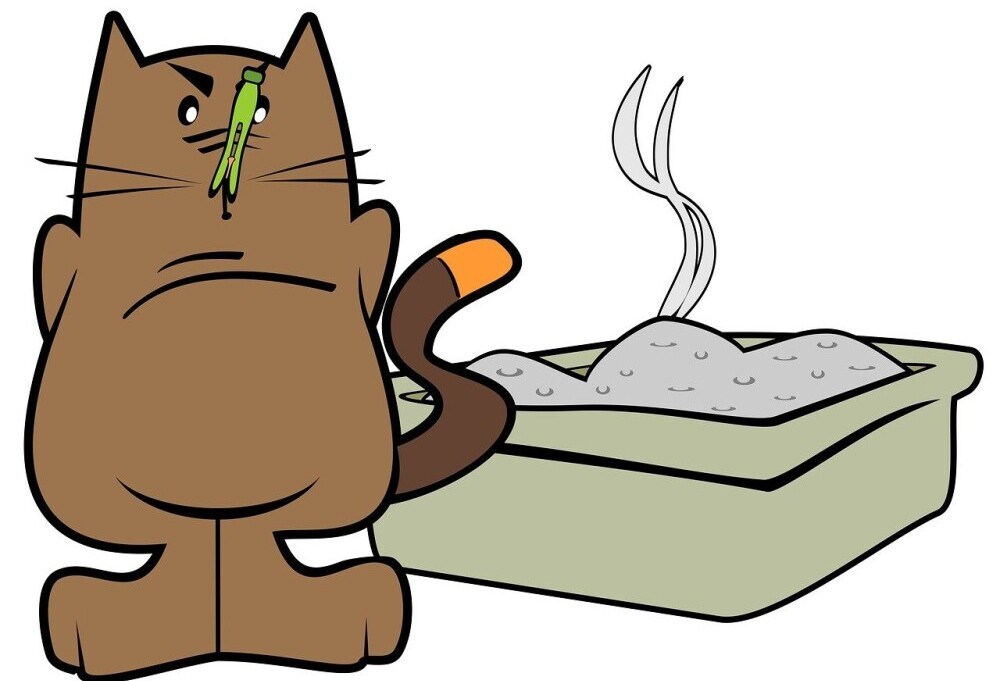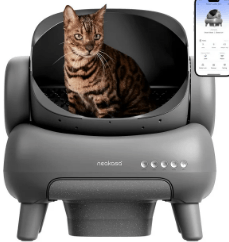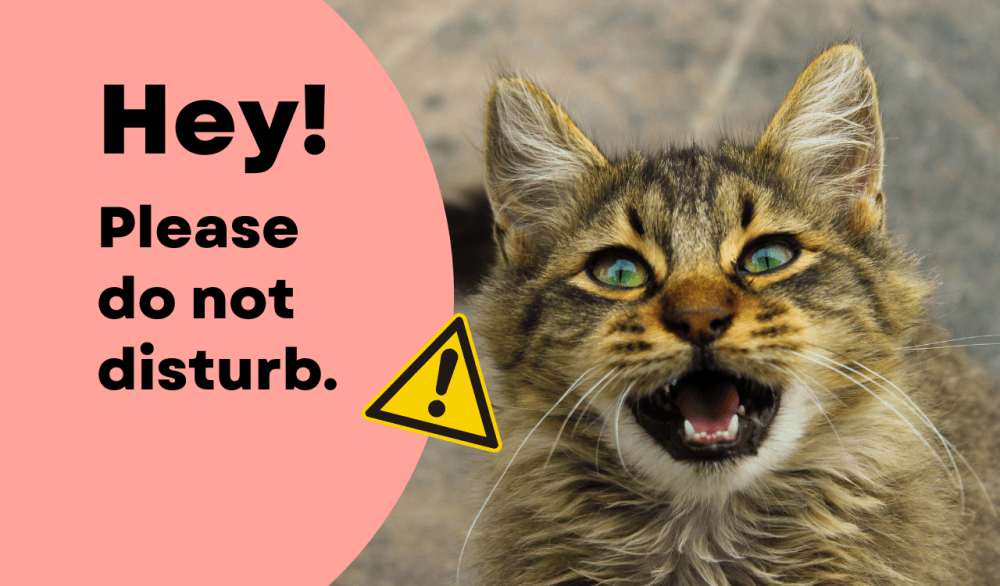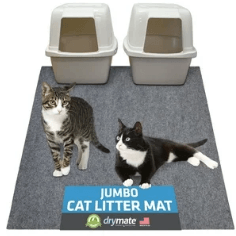This post contains affiliate links, which means I may earn money from products and services you purchase through my links.
Keeping the cat litter box clean doesn’t have to be difficult. Discover practical ways to make this task faster and more efficient. You and your cat will appreciate a clean-smelling litter box. Daily cleaning tips, deep-clean routines, and helpful items are useful for managing litter box messes.
These five steps give new meaning to the words ‘clean litter box.’
We house sit cats all the time. We don’t mind cleaning the litter box and find these simple steps very effective. We understand the association between clean litter boxes and happy pets.
1. Choose the Right Litter for Easy Maintenance
The first step in keeping the cat litter box clean is choosing the right litter. There are several to choose from – clumping, non-clumping, scented, and natural alternatives. The one you pick must control smells and make cleaning easy.
Types of Cat Litter: Which is best for Cleanliness?
The kind of cat litter you use impacts how clean the litter box stays. If you are a new cat owner, the different types of litter can be confusing.
Clumping litter: Clumping litter keeps boxes fresh by forming solid clumps around moist spots. It saves time because the litter is easier to sweep away and reduces the need for full box changes.
Non-clumping litter: This type of litter needs to be changed frequently because it absorbs moisture. The good news is that it is dust-free, prevents odours, and is good for cats with respiratory problems.
Silica gel (crystal litter): Silica gel has exceptional absorption and odour control so you can scoop less.
Natural litters: Environmentally conscious owners might prefer to use natural litters, made from wood, corn or wheat. Many are biodegradable but can require extra cleaning time because litter tends to land outside the box.
We have experience with all of these. For convenience’s sake, I do like the clumping litter. Walmart carries clumping litter that is 7–10 times stronger than others. They even have a multi-cat litter.
How Often Should You Change the Cat Litter?

Your cat’s behaviour and the type of litter will indicate how often to change the litter box. It is best to scoop every day and do a thorough cleaning once a week, or more, depending on the number of cats.
Silica gel or crystal litter lasts longer between changes because it absorbs moisture and locks in odour. To keep the box fresh, scoop daily and do a full cleaning at least once a month.
The frequency of natural or biodegradable litter replacement depends on the materials it is made of and how well it controls odour.
At our house sits, the owners usually tell us when the litter was last changed. We use common sense and if we notice strong smells, we change it.
2. Tools and Techniques to Keep a Cat Litter Box Clean
Scooping daily is one of the simplest ways to maintain a clean cat litter box. It may seem like a lot of work, but it’s best to remove waste before it begins to smell.
We scoop at least once a day; if there are many cats, we do it twice daily. When I say we, it is usually my husband, CJ.
Tools That Make Daily Scooping Easier
Save time and frustration using the proper tools to make daily scooping faster and more efficient.
Metal scoop: A strong metal scoop with a slotted design is recommended for cleaning a litter box; it is stronger and can withstand tough clumps without bending or breaking.
Long handle: This can reduce the amount of bending you do. Some scoops come with a stand or holder, which helps to keep it nearby and cleaner between uses.
Disposal of litter waste: This works like a diaper pail. The odour-sealing technology means you remove the waste without making several trips to the trash can. Scoop, drop, and seal for an odour-free, fresh litter box.
Gloves: Gloves that can be washed or thrown away protect hands from dust and germs, especially for cats that kick litter. Use a small dustpan and brush to make cleanup easy.
I never gave much thought to this, but in a few instances the scooper was flimsy, and we had to be careful that it was strong enough to scoop to the bottom of the box without breaking. I think a litter disposal system would be fantastic.

If money is not an issue, this deluxe self-cleaning cat litter box might be more appealing!
The Best Techniques for Odor Control
Daily scooping and waste removal are essential for eliminating odours and germs, especially if you have several cats.
High-quality odour control litter: Clumping litter with activated charcoal or baking soda can eliminate odours. Non-scented litter is best to avoid irritating your cat.
Full litter box cleaning: Depending on the type of litter, a full litter box cleaning should be done weekly or bi-weekly. This ensures freshness and odour control.
Ventilation: Ventilation around the litter box helps to reduce stale odours. You can also opt for an air purifier that won’t irritate your cat’s nose.
3. Regularly Deep Clean the Litter Box
Regardless of daily scooping and the best litter, deep clean the litter box occasionally. This is important for controlling odour, preventing germ build-up, and ensuring your cat’s hygiene and health.
Step-by-Step Guide to a Thorough Litter Box Cleaning
To keep the cat litter box clean, it is important to do a full cleaning periodically. Follow these steps to keep it fresh and odour-free:
- Empty the litter: Remove all the old litter to a trash bag. If possible, wear gloves to protect your hands from dust and germs.
- Rinse with warm water: In a well-ventilated area, use warm water (hot can warp the plastic) to remove any loose particles before you start scrubbing.
- Use mild soap: Avoid harsh chemicals and strong scents. Using a scrub brush, clean the inside of the box and get into the corners. You can also use 1 part vinegar and 3 parts water to remove stubborn stains or strong odours.
- Rinse thoroughly: Rinse to remove any soap that can irritate your cat’s paws and discourage them from using the box.
- Dry completely: This is important as moisture could cause fresh litter to clump. Use a clean towel or air dry in a sunny area.
- Add fresh litter: Refill the box, spreading it evenly; avoid overfilling (it is recommended to use 2-3 inches).
- Clean the surrounding area: Finally, sweep or wipe down the area surrounding the box to keep it neat and odour-free.
Recommended Cleaning Products for a Fresh Litter Box
Here are several recommended products to keep the surrounding area and the cat litter box clean and odour-free.
Mild, Unscented Dish Soap: Unscented dish soap is ideal for scrubbing the inside of the litter box. It is mild on plastic, leaves no residue, and is effective.
White Vinegar: Most people have white vinegar in their kitchen, but if not, it is affordable and readily available. After cleaning, rinse the box well to eliminate the vinegar smell.
Baking Soda: Baking soda is another natural deodorizer that is safe for cats and absorbs odours. Sprinkle a little in the box before adding the litter.
Litter Box Cleaners: Specific enzymatic cleansers are formulated for cleaning litter boxes. They target organic waste, smells, and germs and are ideal if you have several cats.
Rubber Gloves and Scrub Brushes: Wear gloves and use a brush to keep your hands clean and avoid direct contact with litter waste. Both can be cleaned and used again.
Disposable or Washable Liners: Disposable liners are convenient, but washable ones are environmentally friendly. They are great because they contain waste and minimize scrubbing.
4. Place the Litter Box in an Optimal Location
When deciding where to keep the cat litter box, consider several factors. Providing a clean, comfortable area can benefit you and your cat.
Choosing a Spot That Minimizes Mess

Choose a low-traffic area for your cat’s privacy and comfort. Getting out of the litter box without rushing will reduce the amount of litter that gets outside the box or tracking it through the house.
Minimize the mess by placing the litter box on hard, easily cleaned surfaces like tile or laminate flooring. Carpets make cleaning difficult. We have found that if a mat is necessary, a larger one can be placed partially under the box to catch stray litter.
Avoid small places if possible, as they are not well-ventilated. They may be convenient and out of the way, but they allow smells to build up.
Why Ventilation Matters for Reducing Smell
We have mentioned ventilation a few times, so why is it important? A well-ventilated area helps eliminate unpleasant odours trapped in smaller, unventilated areas. This is much more comfortable for your cat and you.
Insufficient ventilation in a small closet or cupboard can accumulate ammonia and other smells. If the smell gets too strong, neither your cat nor you will like it!
What is the best solution? Open spaces or near windows are recommended, with locked windows. Using a small air purifier near the litter box can help reduce odours.
I have a keen sense of smell, so a well-ventilated area helps.
5. Use Liners and Mats to Reduce Mess

Mats and liners can make a difference. They help reduce the mess around litter boxes and ensure faster clean-up. Who doesn’t want to spend less time sweeping up litter?
Benefits of Litter Box Liners to Keep Cat Litter Box Clean
One of the main advantages of using liners is to stop the waste from sticking to the box’s surface by creating a barrier between the box and litter. This makes cleaning easier and reduces smells. All you need to do is lift out the full liner and dispose of it. This is helpful when you have more than one cat.
Liners protect the surface of the litter box from becoming scratched. The liner provides an additional layer when cats dig.
Strong, tear-resistant liners for your litter box prevent messes and keep it clean and fresh.
The Benefits of Litter Mats to Keep the Cat Litter Box Clean
Walking through litter around the litter box is not fun. With a mat, you can contain spills and keep the area around the litter box clean. This minimizes loose particles on the floor and saves time cleaning the area.
Some litter mats are better than others. Look for a high-quality one to remove litter from your cat’s paws. Ensure the mat is large enough to cover the area around the box to catch most of the litter.
Litter mats are easy to clean. Shake them out, vacuum them, or wipe them down often. Some mats are washable, which is convenient.
Conclusion
As you have learned, keeping a cat litter box clean is not that difficult. These five simple steps—the right litter, cleaning often, deep cleaning occasionally, using liners and mats, and choosing the best location—make the job easier and more efficient. You will control odours, minimize messes, and provide privacy for your cat.
This is good for your cat’s health and happiness, and a clean litter box makes your house tidy and welcoming. It’s a win/win for both of you.

We love to travel. For our trip to Mexico, we were able to save money by house sitting, which was something completely new to us. If this is something that interests you, then check out TrustedHousesitters or HouseSitMexico (be sure and use Code thetr6210d47b7cc90 for discount). We hope you visit often.